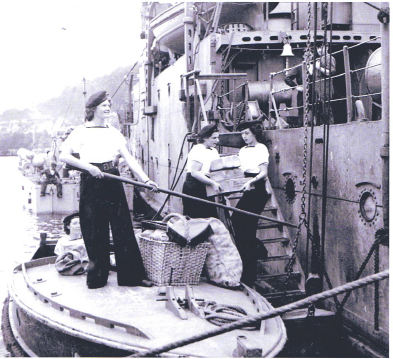Women’s struggle against the patriarchy has long roots. It has been a slow progression with short bursts of fierce activity. One of the most dynamic and fundamental periods of change was the Second World War. Forced into conscripting every possible pair of hands into the war effort for a myriad of new roles, many considered quite beyond women a few years earlier. Very largely, these women seized the opportunities with both hands and never again could it be said that they were incapable of doing the many things which had been thrust on them by the desperate needs of war.
One of the most hidebound and reactionary of all patriarchal forces was the Royal Navy with a deeply embedded chauvinism. Despite this, the WRNS (Women’s Royal Naval Service, its members known as Wrens) was set up in 1939 and was an important adjunct to the naval effort throughout the war. It took several more years of war for the Admiralty’s opposition to be worn down, but from autumn 1941 Wrens started appearing as crew on the Navy’s harbour boats and – much to the Navy’s surprise – these young women were a brilliant success from the start. Tough, determined and deterred by nothing, they worked twenty-four hours a day, seven days a week, in all weathers and never faltered. By the war’s end there were five hundred and fifty of these highly professional specialists. The male Naval establishment got rid of them rapidly in the post-war wind down, but they had left an indelible mark.
My lifetime in the marine world meant I knew what these young women were about and what a marvellous story there was to tell about them. When I turned to full-time writing, a primary goal was to tell that story. A lot of research was still needed, as a feature of novels set against a tapestry of real times and events is that backcloth has to be accurate and correct. And as I researched, the story of Wren Jane Beacon came together. Writing novels gave me the freedom to have my heroine doing great things so it became the preferred way of telling the story through one girl’s adventures from the beginning of the war. And what adventures they were: taking a boat to Dunkirk and rescuing soldiers, battling with the male establishment at every turn, going on to operate her own boat on the tidal Thames through the blitz with an all-female wren crew; these were the pioneers which led to wider acceptance.
The first four books are now available on Kindle and as KDP paperbacks, taking the story through to mid-1941. Book four is different – our heroine is sent on an investigative trip on a canal narrow-boat pair to see if wrens could provide crews for them and the war is (mostly) far way. But she has many other challenges to overcome which leave a permanent mark on her and this short novella has its place in the series. After that it’s back to the Navy and the whole series will be about twelve books long, taking her through to adventures in the Baltic in 1946 after she has been demobbed.
Like all high-spirited young women she has a lively love life as well. War always brings a loosening of moral strictures and world war two was no exception. But at that time it wasn’t done to say so; nowadays in a changed moral climate the writer can be more honest about the activities of that time and in the course of the war our heroine finds love and sex, not always together. But there are deep reflections on true love, loss and forging a new way of taking control of her own body, her own emotions, and her own commitments. It makes for quite a package.


